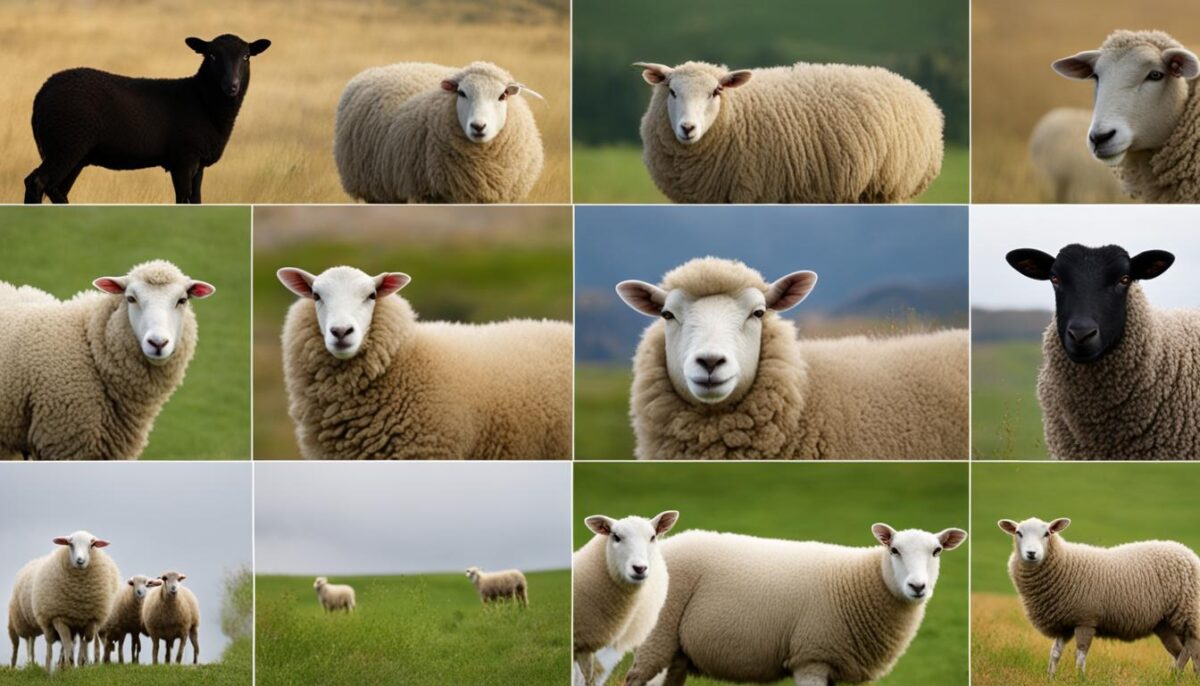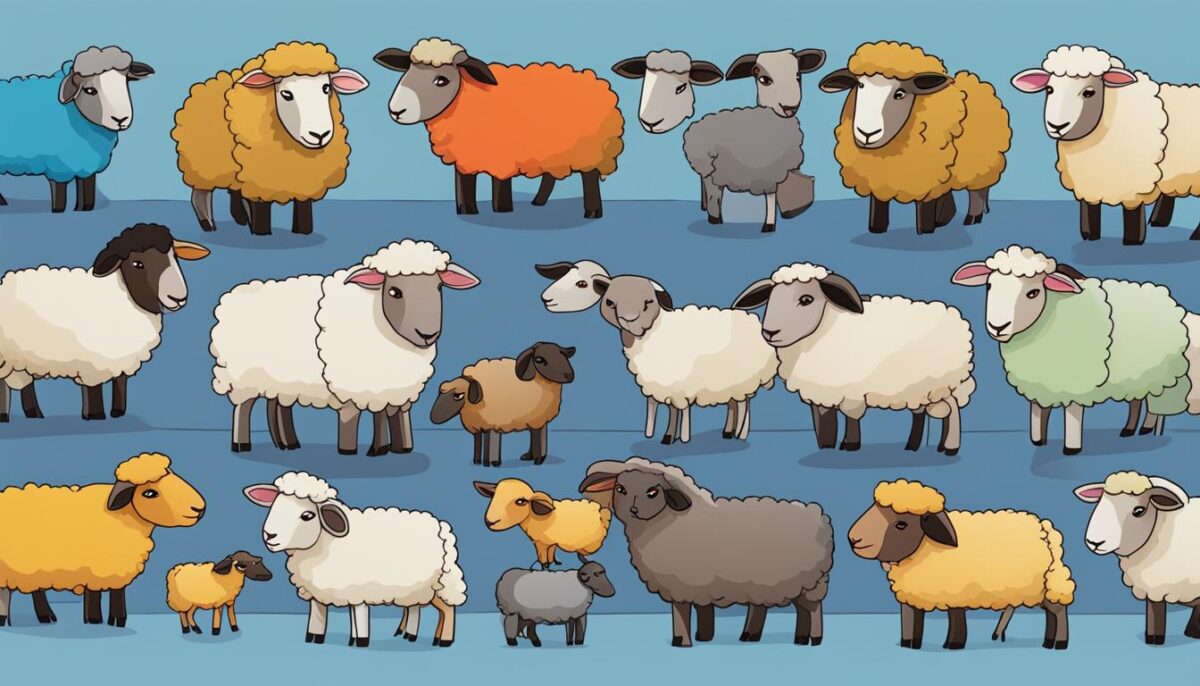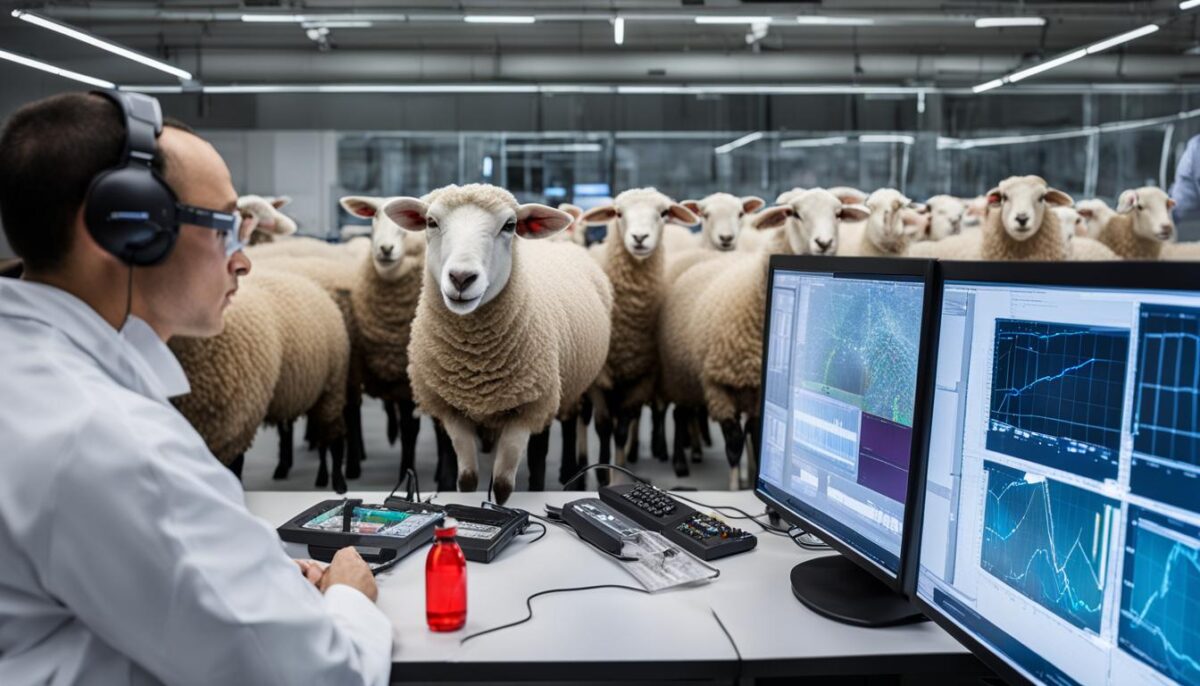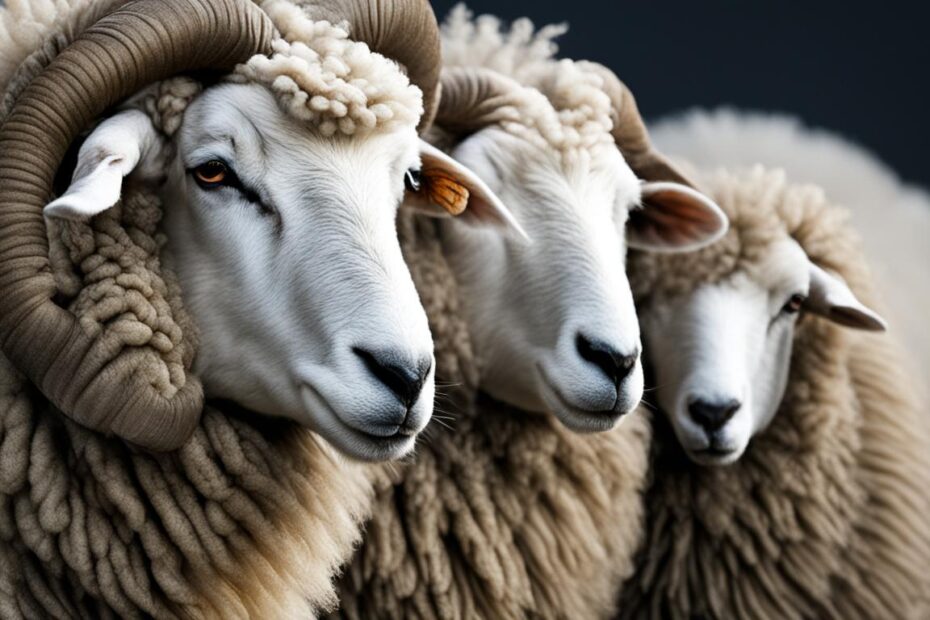Sheep have a unique pupil shape that sets them apart from other animals. Their pupils are horizontal slits, which is different from the round or vertical pupil shapes seen in many other species. This horizontal shape is believed to be an adaptation to their grazing behavior and the need to have a wide field of vision. It allows sheep to have a panoramic view of their surroundings, making it easier for them to spot potential predators and navigate their environment.
Key Takeaways:
- Sheep have horizontal slits as pupils, which is unique among animals.
- The horizontal pupil shape is believed to be an adaptation for grazing and wide field of vision.
- Sheep’s pupil shape helps them spot predators and navigate their environment.
- The shape reduces the glare of the sun, enabling better vision in bright daylight.
- Sheep’s unique pupil shape adds to their cultural symbolism and significance.
Understanding the Anatomy of Sheep Eyes
Sheep have several distinct anatomical features that contribute to the shape and functionality of their eyes. The cornea, a transparent layer at the front of the eye, helps protect the eye and refract light. The iris, which gives sheep their characteristic horizontal pupil shape, controls the amount of light entering the eye. The lens focuses incoming light onto the retina, which is responsible for capturing images. These structures work together to enable sheep to see clearly and adapt to different lighting conditions.
One key feature of sheep eyes is the horizontal shape of their pupils. This unique adaptation allows sheep to have a wide field of vision, which is important for their grazing behavior. The horizontal pupil shape provides sheep with a panoramic view of their surroundings, making it easier for them to spot potential predators and navigate their environment. It also helps reduce the harsh glare of the sun, improving visibility in bright daylight.
Understanding the anatomy of sheep eyes helps us appreciate the intricate design of these animals’ visual system. From the transparent cornea to the adaptable iris and the image-capturing retina, each component plays a crucial role in enabling sheep to see and survive in their natural habitats. By studying the anatomy of sheep eyes, researchers can gain valuable insights into the functionality of their unique pupil shape and further our understanding of animal vision as a whole.
| Sheep Eye Features | Description |
|---|---|
| Cornea | A transparent layer at the front of the eye that protects the eye and helps refract light. |
| Iris | Gives sheep their characteristic horizontal pupil shape and controls the amount of light entering the eye. |
| Lens | Focuses incoming light onto the retina, which captures images. |
| Retina | Responsible for capturing images and sending visual information to the brain. |
Evolutionary Reasons for Sheep’s Horizontal Pupils
Sheep’s horizontal pupil shape is not just a random quirk of nature, but rather an evolutionary adaptation that has allowed these animals to thrive in their natural environments. The unique shape of sheep pupils is believed to have developed as a result of their grazing behavior and the need for enhanced visual awareness.
By having horizontal slits as pupils, sheep are able to maximize their field of vision, allowing them to detect potential predators from various directions while grazing in open pastures. This evolutionary advantage provides sheep with a panoramic view of their surroundings, improving their chances of survival. The ability to spot threats quickly and efficiently is crucial for these herbivores in order to evade predators and protect themselves.
Through countless generations, sheep with horizontal pupils had a greater chance of survival, passing their genetic traits on to their offspring. Over time, this led to the prevalence of horizontal pupils among sheep populations. This remarkable adaptation showcases the remarkable ability of organisms to evolve in response to their environment, ensuring their survival and success.

The Evolutionary Advantage of Horizontal Pupils
The horizontal pupil shape in sheep not only provides them with a wide field of vision but also helps reduce the harsh glare of the sun. This adaptation allows sheep to see clearly and navigate their surroundings even in bright daylight. Additionally, the horizontal pupil shape helps sheep adapt to different lighting conditions and maintain optimal vision, enhancing their ability to find food and survive in changing environments.
In summary, the horizontal pupil shape of sheep is an evolutionary adaptation that has developed over time to meet the specific needs of these grazing animals. It provides them with a wide field of vision, allowing them to detect predators more effectively and navigate their surroundings with ease. The remarkable nature of this adaptation highlights the intricate ways in which evolution shapes the characteristics of different species, enabling them to thrive in their respective habitats.
Comparison of Sheep Pupils with Other Animal Pupils
Sheep have a unique pupil shape that sets them apart from many other animals. While sheep have horizontal pupils, there are various other pupil shapes found in the animal kingdom. The comparison of sheep pupils with those of other animals provides insights into the diversity and functionality of different pupil shapes.
Predatory Animals
Predatory animals like cats have vertical slit pupils. The vertical shape allows them to accurately judge distances and focus on their prey. This pupil shape is advantageous for hunting and enables cats to navigate various terrains effectively.
Grazing Animals
Sheep, along with other grazing animals such as goats and horses, have horizontal slit pupils. This shape is believed to be an adaptation to their grazing behavior and the need for a wide field of vision. Having horizontal pupils allows grazing animals to have a panoramic view of their surroundings, maximizing their ability to detect potential threats from different directions.
Birds and Reptiles
Birds and reptiles have circular pupils that can contract or dilate to regulate the amount of light entering their eyes. This adaptability helps them adjust to different lighting conditions and enhances their visual clarity.
The Functionality of Sheep Pupils
One of the most intriguing aspects of sheep’s unique pupil shape is its functionality and how it enhances their vision. The horizontal slits of their pupils serve a crucial purpose in helping sheep navigate their environments, spot potential threats, and adapt to different lighting conditions.
Unlike humans and other animals with round or vertical pupils, sheep have horizontal pupils that provide them with a wide field of vision. This panoramic view allows them to have a greater spatial awareness and detect predators approaching from various directions.
In addition to their wide field of vision, the horizontal pupil shape helps reduce the glare of the sun. This adaptation enables sheep to see more clearly in bright daylight, preventing excessive light from impairing their vision. By reducing the intensity of sunlight, sheep can comfortably graze and explore their surroundings without being visually overwhelmed.
Sheep Pupil Functionality at a Glance:
- Enhanced field of vision
- Improved ability to detect predators
- Reduced glare in bright daylight
Sheep’s pupil functionality is a testament to the remarkable adaptations found in nature. By understanding the unique characteristics of sheep pupils, we gain insights into the intricacies of animal vision and how different species have evolved to survive and thrive in their respective habitats.
The Cultural Significance of Sheep Pupil Shape
Sheep have long held cultural significance in various societies around the world. Their gentle nature, soft fleece, and distinct appearance, including their unique pupil shape, have made them symbols of various traits and values. The symbolism associated with sheep eyes can be seen in art, literature, and religious traditions.
“The mesmerizing gaze of sheep with their horizontal pupils can captivate observers and evoke feelings of calmness and serenity.”
In many cultures, sheep are often associated with innocence and docility. The horizontal shape of their pupils adds to their distinctive appearance and may contribute to their cultural symbolism. The captivating gaze of sheep with their horizontal pupils can evoke feelings of tranquility and peace. Artists, writers, and poets have often used sheep as symbols of purity, humility, and contentment.
The Symbolism in Art and Literature
- Throughout history, sheep have been depicted in paintings and sculptures, symbolizing purity and innocence.
- Writers and poets have used sheep as metaphors for vulnerability, simplicity, and the need for protection.
- In religious texts and traditions, sheep have been associated with spirituality, sacrifice, and the concept of a caring shepherd.
The cultural significance of sheep and their unique pupil shape showcases humanity’s long-standing connection and fascination with these animals. Their gentle and peaceful nature, as portrayed through their horizontal pupils, continues to inspire art, literature, and cultural symbols.
| Symbol | Meaning |
|---|---|
| Innocence | Sheep have been seen as symbols of purity and innocence, representing an unspoiled and gentle nature. |
| Docility | Sheep’s calm and passive demeanor, enhanced by their horizontal pupil shape, has made them symbols of docility and meekness. |
| Protection | Sheep are often associated with the need for protection and care, emphasizing their vulnerability and reliance on a shepherd figure. |

Conservation efforts for Sheep and their Unique Pupil Shape
Conserving sheep populations is not only crucial for biodiversity and ecosystems but also plays a role in protecting their unique pupil shape. By preserving natural habitats and implementing sustainable farming practices, conservation efforts aim to safeguard the overall well-being of sheep and maintain their distinctive characteristics.
Protecting sheep habitats is essential as it ensures the availability of suitable grazing areas and minimizes environmental degradation. By maintaining diverse vegetation and preventing habitat fragmentation, conservation initiatives support the natural behaviors and adaptations of sheep, including their horizontal pupil shape.
In addition to habitat preservation, efforts are focused on promoting sustainable farming practices that prioritize the welfare of sheep. These practices include responsible grazing management, ensuring access to clean water sources, and implementing animal welfare standards.
Conservation organizations also work towards raising awareness about the importance of sheep conservation and their unique pupil shape. By educating communities about the ecological role of sheep and their significance in cultural heritage, these efforts seek to foster a sense of responsibility and appreciation for these animals.
The Future of Sheep Pupil Research
While the horizontal pupil shape of sheep has been the subject of some investigation, there is still much more to discover regarding its functionality and potential advantages. Future research in this field holds great promise for enhancing our understanding of sheep pupil functionality and its impact on their vision and survival.
Scientists and researchers can explore the specific mechanisms through which sheep utilize their horizontal pupils, shedding light on how these adaptations contribute to their overall visual capabilities. By delving deeper into the intricacies of sheep pupil shape, we may uncover valuable insights that could have implications beyond the realm of animal vision research.
Exploring the functionality of sheep pupils may not only contribute to our understanding of these unique animals but also provide new perspectives on visual adaptations in other species. These findings could potentially improve our knowledge of visual perception and inspire advancements in fields such as optics and ophthalmology.
Areas of Future Research
- Investigating the role of sheep pupil shape in different lighting conditions and its impact on visual acuity.
- Examining how sheep utilize their panoramic field of vision to detect predators and navigate their surroundings.
- Studying the relationship between sheep pupil shape and their grazing behavior, exploring whether it influences feeding efficiency.
- Exploring potential genetic factors that contribute to the development of horizontal pupils in sheep.
By focusing on these areas of research, we can unlock a deeper understanding of the functional advantages and evolutionary significance of sheep pupil shape, enriching our knowledge of this remarkable adaptation and its implications.
| Area of Research | Key Questions |
|---|---|
| Impact of pupil shape on visual acuity | How do horizontal pupils affect the clarity of vision in different lighting conditions? Can sheep see equally well in both bright sunlight and low light conditions? |
| Panoramic field of vision | How does the panoramic field of vision provided by horizontal pupils contribute to sheep’s ability to detect predators? Does it give them an advantage over species with other pupil shapes? |
| Pupil shape and feeding efficiency | Does the horizontal pupil shape of sheep influence their feeding efficiency? Do sheep with different pupil shapes exhibit variations in their grazing behaviors? |
| Genetic factors | Are there specific genetic traits or mutations associated with the development of horizontal pupils in sheep? Can these traits be linked to other visual adaptations or behaviors? |

“The more we delve into the mysteries of sheep pupil shape, the more we uncover fascinating insights into the world of animal vision. Future research in this field holds the potential to not only deepen our understanding of sheep but also shed light on the adaptive capabilities of other species.”
Conclusion
The unique horizontal shape of sheep pupils is a remarkable adaptation that sets them apart from other animals. This distinct pupil shape, with its horizontal slits, enables sheep to have a wide field of vision and better detect potential threats in their environment. Through their evolution, sheep have developed this remarkable advantage to survive and thrive in their natural habitats.
Understanding the functionality and significance of sheep pupil shape adds to our knowledge of animal vision and highlights the incredible diversity found in the natural world. The horizontal pupils of sheep not only allow them to spot predators from different directions but also aid in navigating complex landscapes and finding food more efficiently. Furthermore, this particular pupil shape helps reduce the harsh glare of the sun, enabling sheep to see clearly even in bright daylight.
Further research and conservation efforts are essential to fully appreciate and protect the unique characteristics of sheep, including their one-of-a-kind pupil shape. By studying the intricacies of sheep pupil shape, we can gain insights into animal vision and potentially uncover new discoveries that have broader implications in vision research. Preserving and conserving sheep populations and their natural habitats will ensure that these fascinating creatures continue to thrive and contribute to the ecological balance of our ecosystems.
FAQ
What is unique about the shape of sheep pupils?
Sheep have horizontal slit-shaped pupils, which sets them apart from other animals.
Why do sheep have horizontal pupils?
The horizontal pupil shape is believed to be an adaptation for their grazing behavior and the need for a wide field of vision.
How do sheep pupils differ from other animal pupils?
Predatory animals like cats have vertical slit pupils, while grazing animals like sheep have horizontal slit pupils.
What is the functionality of sheep pupils?
Sheep’s horizontal pupils allow them to have a wide field of vision, spot potential predators, and navigate their environment.
Do sheep pupils have cultural significance?
Yes, sheep with their unique pupil shape are often associated with traits like innocence and docility.
Are there conservation efforts focused on protecting sheep pupils?
Conservation efforts for sheep primarily focus on preserving their natural habitats and supporting biodiversity.
What is the future of sheep pupil research?
Future research could explore the specific mechanisms and advantages of sheep’s horizontal pupil shape.


